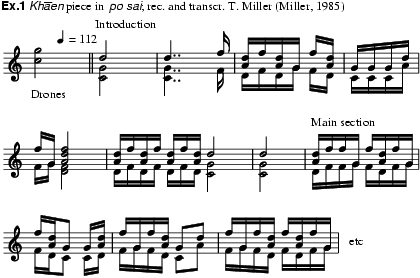
Bamboo free-reed mouth organ of Laos and north-east Thailand. It consists of bamboo pipes grouped together in two rows and graduated from longest to shortest. The free reeds of a copper-silver alloy are mounted in the pipe walls inside a carved wooden windchest called tao (‘gourd’). The openings around the windchest are caulked with a kind of insect waste called khisut. Finger-holes are burnt above the windchest so that all the fingers may be used to open and close the holes. Khaen are made in four sizes: khaen hok (‘six’), a child’s toy with six pipes; khaen jet (‘seven’) with 14 pipes; khaen paet (‘eight’) with 16 pipes; and khaen kao (‘nine’) with 18 pipes. By the 1970s khaen paet were nearly universal, measuring approximately one metre in length, although instruments measuring two to three metres were common before about 1950. Although found throughout north-east Thailand and Laos, khaen making is centred in Roi Et province and especially in the sub-district town of Sī Kaeo. Khaen are properly held tilted to the left or right with the hands cupped over the windchest. The 16 pipes of the khaen paet play 15 pitches (one doubled at the unison) within a range of two octaves consisting of semitones and whole tones averaging 100 and 200 cents respectively. Although there is certainly no Western influence, the pitches may be compared to the piano’s naturals from a to a'', but their physical arrangement follows no recognizable pattern. Instead the pipes have been arranged to facilitate fingering and to avoid the technical problem of playing three consecutive pipes. Inhaling and exhaling produce identical pitches, but pipes sound only when fingerholes are covered.
Whether playing solo or accompanying a singer, khaen players, who are virtually always male, have at their disposal three pentatonic modes (lai) for each of the region’s two commonly known scale systems, called san (expressible as G–A–C–D–E or 5–6–1–2–3) and nyai (A–C–D–E–G or 6–1–2–3–5). The san modes are called sutsanaen (G–A–C–D–E), po sai (C–D–F–G–A) and soi (D–E–G–A–B) while the nyao modes are called nyai (A–C–D–E–G) and noi (D–F–G–A–C); the third nyao mode (E–G–A–B–D) lacks a name. Each mode requires that one or two drones be played either by closing finger-holes with either the fingers or bits of khisut wax. Notes are played singly, in octaves, or in combination with other notes (ex.1). Khaen players choose a mode according to the singer’s range. Besides modal improvisation in each lai, most competant players also render programmatic pieces such as Maeng phu tom tok (‘Bees around the flowers’), Lom phat sai khao (‘The wind through the hills’) and Lai rot fai (an imitation of a steam engine). Most khaen players in Laos improvise on one of that country’s dozen or so regional vocal accompaniment patterns, rarely naming their playing by its mode. Schools in north-east Thailand sometimes organize khaen ensembles (khaen wong) to play central Thai classical songs. (For illustration see Laos, fig.1.)

GEWM, [iv] (‘Thailand’ T. Miller)
R. de Berval, ed.: ‘Présence du royaume Lao’, France-Asie, xii (1956), 703–1153; Eng. trans., 1959 as Kingdom of Laos
D. Yupho: Khruang dontri Thai [Thai musical instruments] (Bangkok, 1957, 2/1967; Eng. trans., 1960, 3/1987)
J. Chonpairot: Kaen Wong [The khaen ensemble] (Mahasarakam, Thailand, 1972)
T. Miller: ‘Free-Reed Instruments in Asia: a Preliminary Classification’, Music East and West: Essays in Honor of Walter Kaufmann, ed. T. Noblitt (New York, 1981), 63–100
T. Miller: Traditonal Music of the Lao: Kaen Playing and Mawlum Singing in Northeast Thailand (Westport, CT, 1985)
TERRY E. MILLER